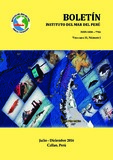Por favor, use este identificador para citar o enlazar este ítem:
https://hdl.handle.net/20.500.12958/3095| Título : | Análisis de la meta-estructura comunitaria del macrobentos de fondo blando en la bahía Almirantazgo, estrecho de Bransfield y alrededores de la isla Elefante |
| Otros títulos : | Analysis of the meta structure community of macrobenthos bottom soft in Admiralty Bay, Bransfield Strait and around the Elephant Island |
| Autor : | Quipuzcoa Olguín, Luis Marquina Herrera, Robert Yupanqui Cuadros, Williams |
| Palabras clave : | Macrobentos;Biomasa;Bahía Altamirantazgo;Estrecho De Bransfield;Isla Elefante |
| Fecha de publicación : | 2016 |
| Editorial : | Callao |
| Citación : | Bol Inst Mar Perú 31(2), 2016: p. 183-193 |
| Citación : | Boletín IMARPE;Vol. 31 n° 2, 2016 |
| Resumen : | Se obtuvieron estimaciones de abundancia y biomasa bentónica, en seis estaciones entre 40 y 510
m de profundidad en la bahía Almirantazgo (BA); dos estaciones a 65 y 115 m alrededor de isla Elefante
(IE) y una estación a 96 m de profundidad frente a isla Astrolabio (IA). El mayor esfuerzo se realizó en BA,
caracterizada por sedimentos fango arcilloso ligeramente compactos y con mucho contenido de piedras.
Núcleos de abundancia superiores a 4.000 ind.m-2 se observaron a menos de 400 m; inversamente la biomasa
registró máximos valores a mayor profundidad. Tanto en BA como en IA, dominaron numéricamente
Polychaeta (67%) y Amphipoda (12%). En biomasa al interior de BA resaltaron los Bivalvia (34%), Sipuncula
(27%) y Polychaeta (23%). Alrededor de IE la estación profunda registró la mayor diversidad, caracterizada
en 90% por Polychaeta. Es importante el aporte de Porífera frente a la Estación Científica Antártica Machu
Picchu (ECAMP). Otros grupos frecuentes fueron Echinodermata Asteroidea (BA), Ofiuroidea relevantes
en biomasa en la E12 (IA) y Holothuroidea dominante en A1. Las clases Ascidiacea y Porífera, estuvieron
representadas por especies solitarias, algunas de gran tamaño (F y E12). Pequeños Cnidaria-Actiniaria fueron
observadas en BA con poca abundancia y biomasa. Los moluscos numéricamente menores, estuvieron
representados por cuatro clases: Gasterópoda, Bivalvia, Polyplacophora y Scaphopoda. ABSTRACT: We obtained estimates of abundance and benthic biomass, in six stations between 40 - 510 m of depth in Admiralty Bay (AB); two stations at 65 and 115 m around Elephant Island (EI) and a station at 96 m depth off Astrolabe Island (AI). Every effort was made in AB, characterized by slightly compact silty mud sediment and with great content of stones. Nucleus of abundance exceeding 4 000 ind.m-2 are observed to less than 400 m; different the biomass recorded maximum values at greater depths. Both AB and AI, numerically dominated Polychaeta (67%) and Amphipoda (12%). In biomass inside AB highlighted the Mollusca Bivalvia (34%), Sipuncula (27%) and Polychaeta (23%). Around EI deep station recorded the greatest diversity, characterized by 90% by the Polychaeta. Important is the contribution of Porifera opposite the Station Scientific Antarctic Machu Picchu (ECAMP). Other frequent groups were Echinodermata Asteroidea (AB), relevant Ofiuroidea on biomass in the E12 (AI) and dominant Holothuroidea in A1. Class Ascidiacea as Porifera, were represented by solitary species, some large (F and E12). Small Cnidaria-Actiniaria were observed in AB with low abundance and biomass. Four classes represented numerically smaller mollusk: Gastropod, Bivalvia, Polyplacophora and Scaphopoda. |
| Descripción : | Boletín IMARPE vol.31, nº 1, 2016; p. 183-193 |
| URI : | https://hdl.handle.net/20.500.12958/3095 |
| Aparece en las colecciones: | Boletín 31(2), 2016 |
Ficheros en este ítem:
| Fichero | Descripción | Tamaño | Formato | |
|---|---|---|---|---|
| Boletin 31(2)-5.pdf | 2,8 MB | Adobe PDF |  Visualizar/Abrir |
Este ítem está sujeto a una licencia Creative Commons Licencia Creative Commons

